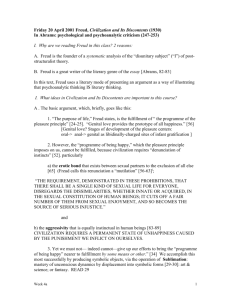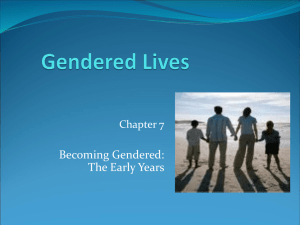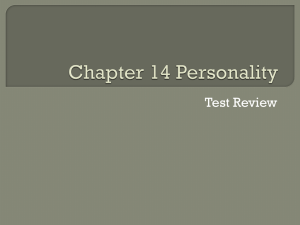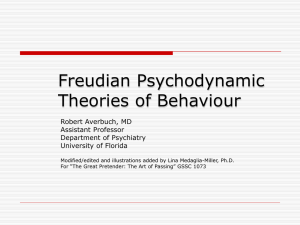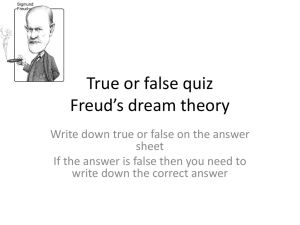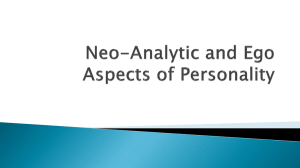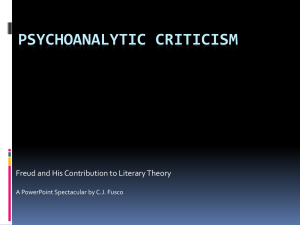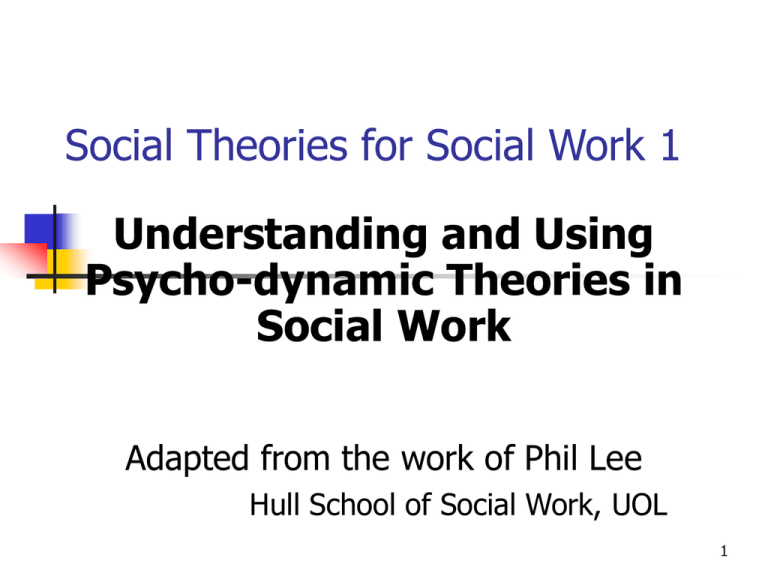
Social Theories for Social Work 1
Understanding and Using
Psycho-dynamic Theories in
Social Work
Adapted from the work of Phil Lee
Hull School of Social Work, UOL
1
What this session will cover
What is psycho-dynamic theory?
Freud’s Contribution – as philosopher / doctor
The Human Mind – libido; stages of childhood
development; Oedipus complex; id, ego & superego;
defence mechanisms
Does any of this make any sense - fit in with our own
experiences?
What Use is all this to Social Work?
Later developments – particularly attachment theory
Strengths and weaknesses – as a theory, and as a
guide to practice
2
What is psycho-dynamic theory?
The MIND is central - unlike in behaviourism
Both conscious and unconscious mind
biological aspects
cognitive
affective dimensions / feelings
All of this is taking place within our minds:
singly and interactively
Taking account of the culture - social environment
Recognition of actual and potential conflicts within us
& between our selves & the environment
OK, but what does it have to offer as a theory and a
guide to social work practice?
3
Freud’s Contribution –
philosopher and doctor
As a philosopher interested in:
Mental functioning – the mind
How civilisation was possible (after
Darwin’s revelations)
How humans think distinctively
As a doctor interested in:
Behaviours that caused distress and not
seen as ‘normal’ – hysteria; neuroses;
phobias; irrational fears
In short, Mental illnesses / mental
disorder
4
a)
Civilisation – How is it Possible?
Humans are directed by 2 conflicting principles:
-
Pleasure – provides energy and
drives us to do what pleases us
Reality – attempts to subordinate
pleasure to immediate vital tasks
Reality Principle subordinates through the
mechanism of sublimation :
…..desires that cannot or should not be
fulfilled can be sublimated – the direction
of their energy altered – into activities
that allow us to be more productive
5
Example – Sexual Pleasure
Sex is pleasurable – but can human beings
pursue it without rules? Such as ages of
consent? Monogamy v polygamy?
So, Sexual energy/desire is sublimated
Without these types of processes – altering
basic instinctual drives – civilisation would
not be possible
But original sexual desires do not disappear
- some of them become packed away – or
repressed - into the unconscious
6
b) The Human Mind
The unconscious contains repressed desires that the conscious mind cannot deal with
This unconscious mind is not easily accessible but
can reveal itself in:
-
dreams – symbolic fulfilments of wishes that
have been repressed
slips of tongue – revealing repressions
jokes – indication of repressed wishes
These all involve condensation – complex meanings
being rendered into more simple ones, and
displacement – one image or symbol gets pushed
onto something closely associated with it
7
Mental Distress
Freud rejected the conventional
physiological explanations of ‘abnormal’
behaviour
He recognised that the key to explaining
much mental distress lay in the study of
‘normal’ human behaviour
All behaviour could only be understood by
seeking out its meaning for the person
This was not easy – the unconscious etc –
and required a method of analysis
8
Libido – The Force
For Freud – as we have seen - humans are
driven by an energy (drives) directing
what we think and do
Untrammelled the human is a “seething
cauldron of fear, emotion and irrationality”
At root is the Libido – sexual desire – but
not simply genital sexual desire
Freud later argued that aggression too was
part of this libidinal force (the natural fight
v flight instinct)
9
Stages of Childhood Development
For Freud the newly born child was “anarchic, sadistic,
aggressive, self-involved & remorselessly pleasure seeking.”
He identified specific developmental phases:
Oral – ingesting - allows self’s boundaries to be established
Anal – expelling – toilet training boundaries between inside/
outside
Phallic – pleasure principle - centred upon sexual identity
So, people can become stuck &/or return to one stage: eg: Anal –
excessive tidiness; Oral – excessive eating, smoking, drinking;
Phallic – attention seeking, flamboyant dress, loud displays
10
Id, Ego & Superego
During childhood, psycho-social development Freud also
identified 3 concepts within the human subject’s mind:
Id – the Unconscious source of
untrammelled instinctual drives/irrational
impulses wanting immediate gratification
Ego – the control centre – conscious and
unconscious attempts to meet the
demands of the Id. So, love and work are
socially acceptable ways to satisfy the Id’s
desire for sex and aggression.
Superego – the internal judge – the value
base of parents, peers, family, society. It
punishes or praises accordingly
11
The Developed Adult
So we all develop – influenced expressly by
the way we have experienced these
various necessary developments
Of crucial importance is the nature of our
early up-bringing – particular our
relationship with our parents and other
siblings
Each of us is unique – for Freud we can
see the imprints of how we have
negotiated the stages he describes through
the defence mechanisms that we
employ as an adult
12
Defence Mechanisms
These distort/falsify our experiences to make it easier
to face - & they operate on an unconscious level
Two very common defence mechanisms:
1. Fixation
If too much gratification is received at any
psychosexual stage, the person may become
stuck / fixated, and return to that stage when
stressed.
2. Repression
An ego defence mechanism, when the ego
pushes discomforting thoughts into the
unconscious, to protect a person’s self image.
13
What Use is all this to Social
Work?
Very influential in early periods as social
work established its most secure
theoretical base in Child Guidance clinics,
in Mental Health settings, in
Counselling………the psychodynamic
casework.
There clearly is important insights here for
social work. What are they?
14
Insights such as………..
That how people form early attachments has
enormous implications for their lives
People’s early experiences can be crucial, & have
crucial - possibly damaging - effects
People can be very well protected – so much so
that it is very tough for them to ‘see’ their own
fallibilities; they lack “insight”
How relationships can cause stress for people –
even when there is no such intent
That many people ‘suffer’ psychological distress
without being fully aware of it
That many of our social conventions protect power
holders & are impositions
15
Later Psycho-dynamic Developments
After 2nd World War – British psycho dynamic thinkers split into 3 groups:
- Anna Freud
- Melanie Klein
- The Middle Group – Bowlby, Rutter &
Winnicott
This latter group developed Attachment
Theory , which has undoubtedly been –
and remains – very important in child care
social work.
16
Social Workers need to be able to:
Evaluate the quality of care provision - “good
enough parenting” – via child/carer interactions
Assess attachment styles & their impact –
understanding the signs of secure attachment &
the symptoms of insecure attachments Recognise that the immediate social caring
environment promotes internal mental models in
the psychodynamic dynamic sense –
Plan to prevent ‘chain of adversity’ reactions for
children who have experienced prolonged &
damaging separations…...leading to permanency
planning
17
Potential Weaknesses of Psycho-Dynamic Theory
Very difficult to test empirically – a form of historicism
(Popper)– potential criticisms can be easily dismissed by the
“cognoscenti”
Possibly very elitist – only a very few people can ‘really’
understand it fully
It is very “top down” and reinforces professional power
It is historically bound eg: Freud’s understanding of the
development of female identity and sexuality, and his failure to
recognise sexual abuse as anything other than “fantasy”
It reinforces sexist, homophobic, racial and cultural oppression
It seems irrelevant. As CaseCon coined the phrase – “how do
you feel about the rats?”……social work is largely much
concerned with structural problems like poverty, not feelings.
Tends to possibly under-estimate the role of material factors
Very time consuming and easy to apply clumsily
18
Potential Strengths of Psycho-Dynamic Theory
Opens up areas of study that are clearly important to
human behaviour
Has had a huge impact on the way that we think about
human behaviour & culture e.g. childhood; sexualities;
the unconscious; instincts; drives ; the creativity of
everyday life
Allows us to communicate about our feelings &
understand why dialogue with ‘others’ can become
distorted – Habermas calls it “an emancipatory
science”
Tries to link instinctual, biological, psychological and
sociological factors in a most intriguing and vital
manner. It’s an example of Modernity, an integrated
universal model
19
Potential Strengths of Psycho-Dynamic Practice
in Social Work
Opens up ‘ internal spaces’ in ways that can both
add potential to human experience, and in other
senses make it more difficult….impossible to ignore
Very important resource for SWs dealing with child
safeguarding, statutory interventions, child welfare,
complex family interactions & difficult life
transitions, bereavement, loss, confused older
people, drug addictions,
So, of clear importance as a practice guide in child
care matters, and some mental health situations
Useful where strong defence mechanisms have
developed – some parents of children with learning
or physical disabilities
Key insights can be utilised in more focussed ways
– crisis intervention; task centred work
20





